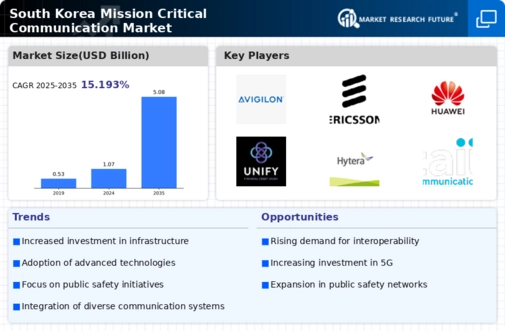Focus on Cybersecurity Measures
As the mission critical-communication market expands, the focus on cybersecurity measures has become paramount. With the increasing reliance on digital communication systems, the risk of cyber threats poses a significant challenge. In South Korea, the government has implemented stringent cybersecurity regulations, allocating around $300 million to enhance the security of communication networks. This regulatory framework aims to protect sensitive data and ensure the integrity of communication systems used by emergency services. Consequently, organizations are investing in advanced cybersecurity solutions, which is expected to drive growth in the mission critical-communication market as they seek to safeguard their operations.
Collaboration Among Stakeholders
Collaboration among various stakeholders is emerging as a key driver in the mission critical-communication market. Partnerships between government agencies, private sector companies, and technology providers are fostering innovation and improving service delivery. In South Korea, initiatives such as public-private partnerships have been established to enhance communication infrastructure and develop new solutions. This collaborative approach is likely to lead to the creation of more integrated and efficient communication systems for emergency services. As stakeholders work together to address challenges and leverage resources, the mission critical-communication market is expected to benefit from increased investment and innovation.
Integration of AI and Data Analytics
The integration of artificial intelligence (AI) and data analytics into the mission critical-communication market is transforming operational capabilities. AI technologies are being utilized to analyze vast amounts of data in real-time, enabling organizations to make informed decisions during critical situations. In South Korea, the government has recognized the potential of AI in enhancing public safety and has invested approximately $500 million in AI-driven communication solutions. This integration not only improves response times but also enhances situational awareness for emergency responders. As organizations increasingly adopt AI technologies, the mission critical-communication market is likely to witness substantial growth.
Advancements in Communication Technology
The mission critical-communication market in South Korea is experiencing a surge due to rapid advancements in communication technology. Innovations such as 5G networks and enhanced satellite communication systems are enabling more reliable and faster communication channels. This is particularly crucial for emergency services and public safety organizations that rely on real-time data exchange. The South Korean government has invested approximately $2 billion in upgrading communication infrastructure, which is expected to bolster the capabilities of mission critical-communication systems. As a result, organizations are increasingly adopting these technologies to improve operational efficiency and response times, thereby driving growth in the mission critical-communication market.
Increased Demand for Public Safety Solutions
There is a growing demand for public safety solutions within the mission critical-communication market in South Korea. This demand is driven by the need for enhanced emergency response systems and disaster management capabilities. According to recent statistics, the South Korean government allocated around $1.5 billion for public safety initiatives in 2025, which includes investments in communication systems. The focus on improving public safety infrastructure is likely to lead to increased adoption of mission critical-communication technologies among law enforcement and emergency services. This trend indicates a robust growth trajectory for the mission critical-communication market as organizations seek to ensure the safety and security of citizens.






















Leave a Comment